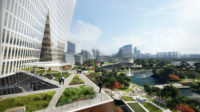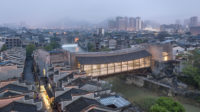A pair of museums designed by Steven Holl Architects will anchor a new cultural district in the Eco-City area of Tianjin. Holl envisions the two museums—one dedicated to ecology and the other to city planning—as complementary buildings, both in terms of their missions and their architectural forms.
A collaboration between the governments of China and Singapore, Tianjin Eco-City is being built on a site in the Binhai New Area that had been a polluted salt pan 25 miles from the center of Tianjin. The 11.5-square-mile-project, which aims to be a model of sustainable development, will have a population of 350,000 when it is completed around 2020. Tianjin is one of the fastest growing cities in China and is developing the Binhai New Area as a second urban core, much as Shanghai has built the Pudong area as a sibling to its historic core in Puxi. Located 95 miles southeast of Beijing, Tianjin is now connected to the capital by a high-speed train that takes just 30 minutes to zip from one city to another.
Holl conceived of his design for the Ecology and Planning Museums as two halves of one institution. The built form of each one is the reverse of the other, as if one were a die and the other the mold in which it had been cast. “One is the solid and the other the void,” explains Holl. The architect placed each 20,000-square-meter building on one side of a public plaza and connected them underground with another 215,000 square feet of space.
The buildings will be poured-concrete structures (made with bamboo forms) and then sprayed with atomized aluminum to give them reflective surfaces. “This is the most radical design I’ve ever done,” states the architect, who completed last year an enormous mixed-use complex in Chengdu that he calls the Sliced Porosity Block and in 2009 a “horizontal skyscraper” for China Vanke in Shenzhen.
As he has done with some of his other projects in China, Holl brought in the China Academy of Building Research as structural engineers. Mechanical engineers at the firm Transsolar are developing a “cooling jacket” for the twin museums—a set of tubes under the buildings’ skins that will expel heat and work with the project’s geothermal wells to heat and cool the interiors.
The Ecology and Planning Museums should break ground in April and be completed about two years later, says Holl. The architect hopes to design the exhibitions inside the buildings. “This project is all about showing that ecology and planning must be interconnected.”














Post a comment to this article
Report Abusive Comment